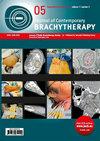用于阴道袖带近距离治疗的调强阴道近距离治疗涂抹器以及单通道和多通道涂抹器
IF 1.1
4区 医学
Q4 ONCOLOGY
引用次数: 0
摘要
目的:比较用于阴道袖带近距离放射治疗(VC-BRT)的阴道强度调制近距离放射治疗(IM-BRT)应用器与单通道近距离放射治疗(SC-BRT)和多通道近距离放射治疗(MC-BRT)应用器的剂量学性能。针对两种不同的临床靶体积(CTV)定义制定了IM-BRT、SC-BRT和MC-BRT治疗方案:1.标准 CTV,称为 CTV;和 2.2.几乎定义的 CTV,称为 CTVv,肿瘤不对称扩展厚度为 5 毫米。结果:根据DVH分析,IM-BRT和SC-BRT计划中CTVv的D98和CTVs及CTVv的D2在统计学上有显著差异,但IM-BRT和MC-BRT计划中CTVs和CTVv的D98和D2没有显著差异。此外,就 CTVv 计划而言,IM-BRT 在直肠(D2cc、V5Gy 和 V7Gy)、膀胱(D2cc 和 V7Gy)和小肠(D2cc、V5Gy 和 V7Gy)方面明显优于 SC-BRT。另一方面,乙状结肠的 DVH 参数在 IM-BRT 和 SC-BRT 方案之间存在较大差异,但在统计学上并不显著。同样,与 MC-BRT 应用器相比,IM-BRT 应用器在所有确定的 OAR 中都显示出明显的剂量减少,但只有直肠 V7Gy 的剂量减少具有统计学意义(p = 0.03)。本文章由计算机程序翻译,如有差异,请以英文原文为准。
Intensity-modulated vaginal brachytherapy applicator and single- and multi-channel applicators in vaginal cuff brachytherapy
Purpose:
To compare the dosimetric performance of vaginal intensity-modulated brachytherapy (IM-BRT) applicator and single- (SC-BRT) and multi-channel brachytherapy (MC-BRT) applicators for vaginal cuff brachytherapy (VC-BRT).
Material and methods:
Fifteen patients with uterine-confined endometrium cancer who received adjuvant VC-BRT were included in this study. IM-BRT, SC-BRT, and MC-BRT treatment plans were created for two different clinical target volume (CTV) definitions: 1. Standard CTV, called CTVs; and 2. Virtually defined CTV, called CTVv, with asymmetrical tumor extension > 5 mm in thickness. Plan comparison was performed using dose-volume histogram (DVH) and treatment planning parameters.
Results:
According to DVH analysis, D98 for CTVv and D2 for both CTVs and CTVv showed statistically significant differences between IM-BRT and SC-BRT plans, but there was no significant difference between IM-BRT and MC-BRT plans in terms of D98 and D2 for both CTVs and CTVv. Additionally, for CTVv plans, IM-BRT was found to be significantly superior to SC-BRT for the rectum (D2cc, V5Gy, and V7Gy), bladder (D2cc and V7Gy), and small bowel (D2cc, V5Gy, and V7Gy). On the other hand, DVH parameters of the sigmoid showed large difference between IM-BRT and SC-BRT plans, but it was not statistically significant. Similarly, the use of IM-BRT applicator demonstrated a noticeable dose reduction in all defined OARs when compared with MC-BRT applicator, but statistically significant for the rectum V7Gy (p = 0.03) only.
Conclusions:
While the IM-BRT applicator is still in pre-clinical phase, our investigation demonstrated the proof-of-concept in real patient treatment plans with promising dosimetric results compared with SC-BRT and MC-BRT plans in selected patient group.
To compare the dosimetric performance of vaginal intensity-modulated brachytherapy (IM-BRT) applicator and single- (SC-BRT) and multi-channel brachytherapy (MC-BRT) applicators for vaginal cuff brachytherapy (VC-BRT).
Material and methods:
Fifteen patients with uterine-confined endometrium cancer who received adjuvant VC-BRT were included in this study. IM-BRT, SC-BRT, and MC-BRT treatment plans were created for two different clinical target volume (CTV) definitions: 1. Standard CTV, called CTVs; and 2. Virtually defined CTV, called CTVv, with asymmetrical tumor extension > 5 mm in thickness. Plan comparison was performed using dose-volume histogram (DVH) and treatment planning parameters.
Results:
According to DVH analysis, D98 for CTVv and D2 for both CTVs and CTVv showed statistically significant differences between IM-BRT and SC-BRT plans, but there was no significant difference between IM-BRT and MC-BRT plans in terms of D98 and D2 for both CTVs and CTVv. Additionally, for CTVv plans, IM-BRT was found to be significantly superior to SC-BRT for the rectum (D2cc, V5Gy, and V7Gy), bladder (D2cc and V7Gy), and small bowel (D2cc, V5Gy, and V7Gy). On the other hand, DVH parameters of the sigmoid showed large difference between IM-BRT and SC-BRT plans, but it was not statistically significant. Similarly, the use of IM-BRT applicator demonstrated a noticeable dose reduction in all defined OARs when compared with MC-BRT applicator, but statistically significant for the rectum V7Gy (p = 0.03) only.
Conclusions:
While the IM-BRT applicator is still in pre-clinical phase, our investigation demonstrated the proof-of-concept in real patient treatment plans with promising dosimetric results compared with SC-BRT and MC-BRT plans in selected patient group.
求助全文
通过发布文献求助,成功后即可免费获取论文全文。
去求助
来源期刊

Journal of Contemporary Brachytherapy
ONCOLOGY-RADIOLOGY, NUCLEAR MEDICINE & MEDICAL IMAGING
CiteScore
2.40
自引率
14.30%
发文量
54
审稿时长
16 weeks
期刊介绍:
The “Journal of Contemporary Brachytherapy” is an international and multidisciplinary journal that will publish papers of original research as well as reviews of articles. Main subjects of the journal include: clinical brachytherapy, combined modality treatment, advances in radiobiology, hyperthermia and tumour biology, as well as physical aspects relevant to brachytherapy, particularly in the field of imaging, dosimetry and radiation therapy planning. Original contributions will include experimental studies of combined modality treatment, tumor sensitization and normal tissue protection, molecular radiation biology, and clinical investigations of cancer treatment in brachytherapy. Another field of interest will be the educational part of the journal.
 求助内容:
求助内容: 应助结果提醒方式:
应助结果提醒方式:


